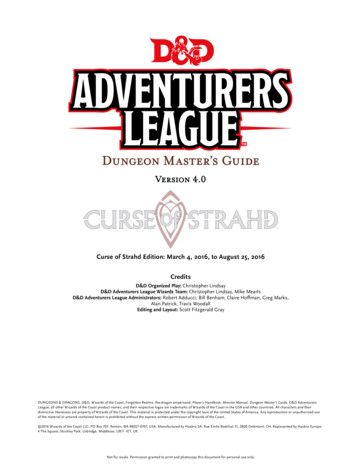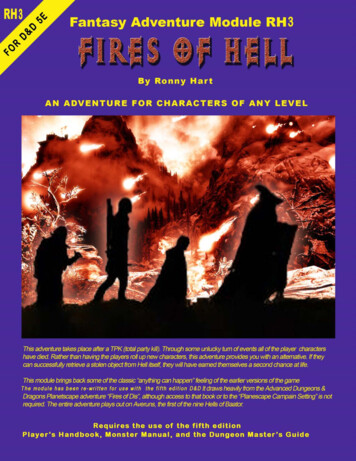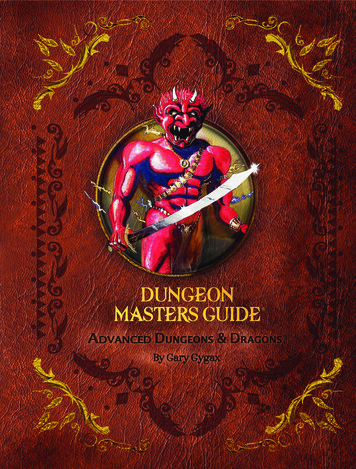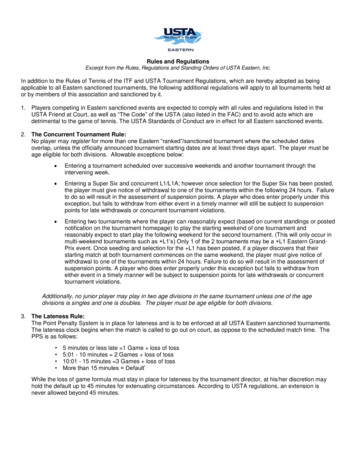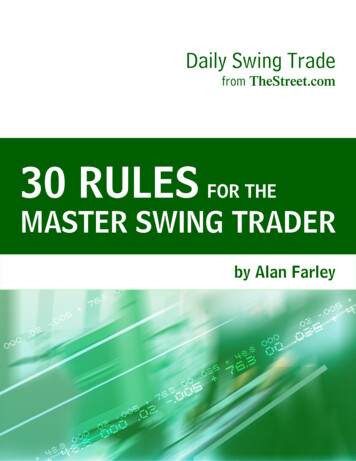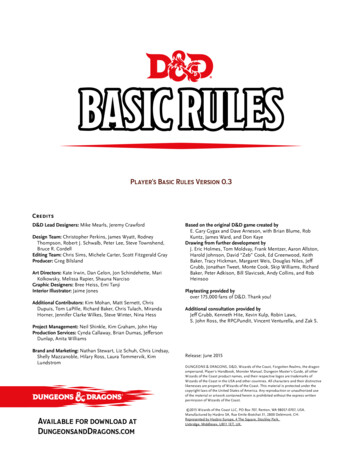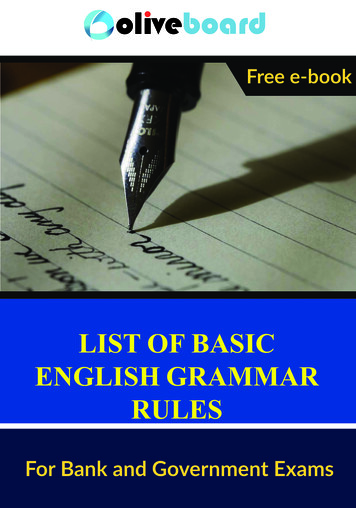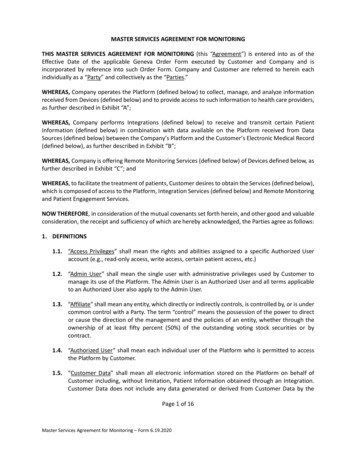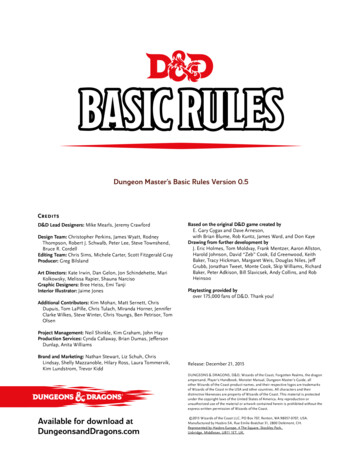
Transcription
Dungeon Master’s Basic Rules Version 0.5CreditsD&D Lead Designers: Mike Mearls, Jeremy CrawfordDesign Team: Christopher Perkins, James Wyatt, RodneyThompson, Robert J. Schwalb, Peter Lee, Steve Townshend,Bruce R. CordellEditing Team: Chris Sims, Michele Carter, Scott Fitzgerald GrayProducer: Greg BilslandArt Directors: Kate Irwin, Dan Gelon, Jon Schindehette, MariKolkowsky, Melissa Rapier, Shauna NarcisoGraphic Designers: Bree Heiss, Emi TanjiInterior Illustrator: Jaime JonesBased on the original D&D game created byE. Gary Gygax and Dave Arneson,with Brian Blume, Rob Kuntz, James Ward, and Don KayeDrawing from further development byJ. Eric Holmes, Tom Moldvay, Frank Mentzer, Aaron Allston,Harold Johnson, David “Zeb” Cook, Ed Greenwood, KeithBaker, Tracy Hickman, Margaret Weis, Douglas Niles, JeffGrubb, Jonathan Tweet, Monte Cook, Skip Williams, RichardBaker, Peter Adkison, Bill Slavicsek, Andy Collins, and RobHeinsooPlaytesting provided byover 175,000 fans of D&D. Thank you!Additional Contributors: Kim Mohan, Matt Sernett, ChrisDupuis, Tom LaPille, Chris Tulach, Miranda Horner, JenniferClarke Wilkes, Steve Winter, Chris Youngs, Ben Petrisor, TomOlsenProject Management: Neil Shinkle, Kim Graham, John HayProduction Services: Cynda Callaway, Brian Dumas, JeffersonDunlap, Anita WilliamsBrand and Marketing: Nathan Stewart, Liz Schuh, ChrisLindsay, Shelly Mazzanoble, Hilary Ross, Laura Tommervik,Kim Lundstrom, Trevor KiddRelease: December 21, 2015DUNGEONS & DRAGONS, D&D, Wizards of the Coast, Forgotten Realms, the dragonampersand, Player’s Handbook, Monster Manual, Dungeon Master’s Guide, allother Wizards of the Coast product names, and their respective logos are trademarksof Wizards of the Coast in the USA and other countries. All characters and theirdistinctive likenesses are property of Wizards of the Coast. This material is protectedunder the copyright laws of the United States of America. Any reproduction orunauthorized use of the material or artwork contained herein is prohibited without theexpress written permission of Wizards of the Coast.Available for download atDungeonsandDragons.com 2015 Wizards of the Coast LLC, PO Box 707, Renton, WA 98057-0707, USA.Manufactured by Hasbro SA, Rue Emile-Boéchat 31, 2800 Delémont, CH.Represented by Hasbro Europe, 4 The Square, Stockley Park,Uxbridge, Middlesex, UB11 1ET, UK.
MonstersGuidelines for understanding the information found in amonster’s statistics are presented below.StatisticsA monster’s statistics, sometimes referred to as its statblock, provide the essential information that you needto run the monster.SizeA monster can be Tiny, Small, Medium, Large, Huge,or Gargantuan. The Size Categories table shows howmuch space a creature of a particular size controlsin combat. See the player’s D&D basic rules or thePlayer’s Handbook for more information on creaturesize and space.Size ace2½ by 2½ ft.5 by 5 ft.5 by 5 ft.10 by 10 ft.15 by 15 ft.20 by 20 ft. or largerExamplesImp, spriteGiant rat, goblinOrc, werewolfHippogriff, ogreFire giant, treantKraken, purple wormTypeA monster’s type speaks to its fundamental nature.Certain spells, magic items, class features, and othereffects in the game interact in special ways withcreatures of a particular type. For example, an arrow ofdragon slaying deals extra damage not only to dragonsbut also other creatures of the dragon type, such asdragon turtles and wyverns.The game includes the following monster types, whichhave no rules of their own.Aberrations are utterly alien beings. Many of themhave innate magical abilities drawn from the creature’salien mind rather than the mystical forces of the world.The quintessential aberrations are aboleths, beholders,mind flayers, and slaadi.Beasts are nonhumanoid creatures that are a naturalpart of the fantasy ecology. Some of them have magicalpowers, but most are unintelligent and lack any societyor language. Beasts include all varieties of ordinaryanimals, dinosaurs, and giant versions of animals.Celestials are creatures native to the Upper Planes.Many of them are the servants of deities, employedas messengers or agents in the mortal realm andthroughout the planes. Celestials are good by nature,so the exceptional celestial who strays from a goodalignment is a horrifying rarity. Celestials includeangels, couatls, and pegasi.Constructs are made, not born. Some areprogrammed by their creators to follow a simple set ofinstructions, while others are imbued with sentienceand capable of independent thought. Golems are theiconic constructs. Many creatures native to the outerplane of Mechanus, such as modrons, are constructsshaped from the raw material of the plane by the will ofmore powerful creatures.Dragons are large reptilian creatures of ancient originand tremendous power. True dragons, including thegood metallic dragons and the evil chromatic dragons,are highly intelligent and have innate magic. Also in thiscategory are creatures distantly related to true dragons,but less powerful, less intelligent, and less magical, suchas wyverns and pseudodragons.Elementals are creatures native to the elementalplanes. Some creatures of this type are little more thananimate masses of their respective elements, includingthe creatures simply called elementals. Others havebiological forms infused with elemental energy. Theraces of genies, including djinn and efreet, form themost important civilizations on the elemental planes.Other elemental creatures include azers, invisiblestalkers, and water weirds.Fey are magical creatures closely tied to the forces ofnature. They dwell in twilight groves and misty forests.In some worlds, they are closely tied to the Feywild, alsocalled the Plane of Faerie. Some are also found in theOuter Planes, particularly the planes of Arborea and theBeastlands. Fey include dryads, pixies, and satyrs.Fiends are creatures of wickedness that are nativeto the Lower Planes. A few are the servants of deities,but many more labor under the leadership of archdevilsand demon princes. Evil priests and mages sometimessummon fiends to the material world to do their bidding.If an evil celestial is a rarity, a good fiend is almostinconceivable. Fiends include demons, devils, hellhounds, rakshasas, and yugoloths.Giants tower over humans and their kind. They arehumanlike in shape, though some have multiple heads(ettins) or deformities (fomorians). The six varieties oftrue giant are hill giants, stone giants, frost giants, firegiants, cloud giants, and storm giants. Besides these,creatures such as ogres and trolls are giants.Humanoids are the main peoples of the D&Dworld, both civilized and savage, including humansand a tremendous variety of other species. They havelanguage and culture, few if any innate magical abilities(though most humanoids can learn spellcasting), and abipedal form. The most common humanoid races arethe ones most suitable as player characters: humans,dwarves, elves, and halflings. Almost as numerous butfar more savage and brutal, and almost uniformly evil,are the races of goblinoids (goblins, hobgoblins, andbugbears), orcs, gnolls, lizardfolk, and kobolds.Monstrosities are monsters in the strictest sense—frightening creatures that are not ordinary, not trulynatural, and almost never benign. Some are theresults of magical experimentation gone awry (suchas owlbears), and others are the product of terriblecurses (including minotaurs and yuan-ti). They defycategorization, and in some sense serve as a catch-allcategory for creatures that don’t fit into any other type.D&D DM’s Basic Rules v0.5 MonstersNot for resale. Permission granted to print and photocopy this document for personal use only.2
Oozes are gelatinous creatures that rarely have afixed shape. They are mostly subterranean, dwellingin caves and dungeons and feeding on refuse, carrion,or creatures unlucky enough to get in their way. Blackpuddings and gelatinous cubes are among the mostrecognizable oozes.Plants in this context are vegetable creatures, notordinary flora. Most of them are ambulatory, and someare carnivorous. The quintessential plants are theshambling mound and the treant. Fungal creaturessuch as the gas spore and the myconid also fall intothis category.Undead are once-living creatures brought to ahorrifying state of undeath through the practice ofnecromantic magic or some unholy curse. Undeadinclude walking corpses, such as vampires and zombies,as well as bodiless spirits, such as ghosts and specters.TagsA monster might have one or more tags appended toits type, in parentheses. For example, an orc has thehumanoid (orc) type. The parenthetical tags provideadditional categorization for certain creatures. The tagshave no rules of their own, but something in the game,such as a magic item, might refer to them. For instance,a spear that is especially effective at fighting demonswould work against any monster that has the demon tag.AlignmentA monster’s alignment provides a clue to its dispositionand how it behaves in a roleplaying or combat situation.For example, a chaotic evil monster might be difficultto reason with and might attack characters on sight,whereas a neutral monster might be willing to negotiate.See the player’s D&D basic rules or the Player’sHandbook for descriptions of the different alignments.The alignment specified in a monster’s stat block isthe default. Feel free to depart from it and change amonster’s alignment to suit the needs of your campaign.If you want a good-aligned green dragon or an evil stormgiant, there’s nothing stopping you.Some creatures can have any alignment. In otherwords, you choose the monster’s alignment. Somemonster’s alignment entry indicates a tendency oraversion toward law, chaos, good, or evil. For example,a berserker can be any chaotic alignment (chaotic good,chaotic neutral, or chaotic evil), as befits its wild nature.Many creatures of low intelligence have nocomprehension of law or chaos, good or evil. They don’tmake moral or ethical choices, but rather act on instinct.These creatures are unaligned, which means they don’thave an alignment.Armor ClassA monster that wears armor or carries a shield hasan Armor Class (AC) that takes its armor, shield, andDexterity into account. Otherwise, a monster’s AC isbased on its Dexterity modifier and natural armor,if any. If a monster has natural armor, wears armor,or carries a shield, this is noted in parentheses afterits AC value.Hit PointsA monster usually dies or is destroyed when it drops to 0hit points. For more on hit points, see the player’s D&Dbasic rules or the Player’s Handbook.A monster’s hit points are presented both as a dieexpression and as an average number. For example,a monster with 2d8 hit points has 9 hit points onaverage (2 4½).A monster’s size determines the die used to calculateits hit points, as shown in the Hit Dice by Size table.Hit Dice by SizeMonster SizeTinySmallMediumLargeHugeGargantuanHit Died4d6d8d10d12d20Average HP per Die2½3½4½5½6½10½A monster’s Constitution modifier also affects thenumber of hit points it has. Its Constitution modifier ismultiplied by the number of Hit Dice it possesses, andthe result is added to its hit points. For example, if amonster has a Constitution of 12 ( 1 modifier) and 2d8Hit Dice, it has 2d8 2 hit points (average 11).SpeedA monster’s speed tells you how far it can move on itsturn. For more information on speed, see the player’sD&D basic rules or the Player’s Handbook.All creatures have a walking speed, simply called themonster’s speed. Creatures that have no form of groundbased locomotion have a walking speed of 0 feet.Some creatures have one or more of the followingadditional movement modes.BurrowA monster that has a burrowing speed can use thatspeed to move through sand, earth, mud, or ice. Amonster can’t burrow through solid rock unless it has aspecial trait that allows it to do so.ClimbA monster that has a climbing speed can use all orpart of its movement to move on vertical surfaces. Themonster doesn’t need to spend extra movement to climb.D&D DM’s Basic Rules v0.5 MonstersNot for resale. Permission granted to print and photocopy this document for personal use only.3
FlyA monster that has a flying speed can use all or part ofits movement to fly. Some monsters have the ability tohover, which makes them hard to knock out of the air(as explained in the rules on flying in the player’s D&Dbasic rules or the Player’s Handbook). Such a monsterstops hovering when it dies.SwimA skill bonus is the sum of a monster’s relevantability modifier and its proficiency bonus, which isdetermined by the monster’s challenge rating (asshown in the Proficiency Bonus by Challenge Ratingtable). Other modifiers might apply. For instance, amonster might have a larger-than-expected bonus(usually double its proficiency bonus) to account forits heightened expertise.A monster that has a swimming speed doesn’t need tospend extra movement to swim.Vulnerabilities, Resistances,and ImmunitiesAbility ScoresSome creatures have vulnerability, resistance, orimmunity to certain types of damage. Particularcreatures are even resistant or immune to damagefrom nonmagical attacks (a magical attack is an attackdelivered by a spell, a magic item, or another magicalsource). In addition, some creatures are immune tocertain conditions.Every monster has six ability scores (Strength,Dexterity, Constitution, Intelligence, Wisdom, andCharisma) and corresponding modifiers. For moreinformation on ability scores and how they’re usedin play, see the player’s D&D basic rules or thePlayer’s Handbook.Saving ThrowsThe Saving Throws entry is reserved for creaturesthat are adept at resisting certain kinds of effects.For example, a creature that isn’t easily charmed orfrightened might gain a bonus on its Wisdom savingthrows. Most creatures don’t have special saving throwbonuses, in which case this section is absent.A saving throw bonus is the sum of a monster’s relevantability modifier and
Dungeon Master’s Basic Rules Version 0.5 Credits D&D Lead Designers: Mike Mearls, Jeremy Crawford Design Team: Christopher Perkins, James Wyatt, Rodney Thompson, Robert J. Schwalb, Peter Lee, Steve Townshend, Drawing from further development by Bruce R. Cordell Editing Team: Chris Sims, Michele Carter, Scott Fitzgerald Gray Producer: Greg .
